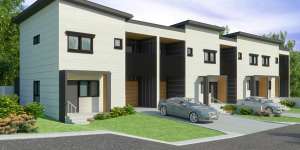In a major shift designed to improve choice and rapidly increase housing numbers,from Monday,all but four NSW councils will be required to consider development applications for dual occupancies,two separate homes on a single lot,and semi-detached homes in low-density zones.

Duplexes,semis and townhouses will be a key part of the mix if NSW is to meet its housing targets.Supplied.
The Hawkesbury,Blue Mountains and Wollondilly local government areas have not been included in the changes because of the risk they face from bushfires and floods. Bathurst has also been excluded because there is no suitable residential land in the council area.
Duplexes and semis used to feature heavily in Sydney’s housing mix,but many councils across greater Sydney banned them. Only two of 32 local environmental plans (LEPs) across Sydney allowed terraces and one- or two-storey blocks in low-density residential (R2) zones.
As part of the planning reforms,councils will now be required to consider greater choice and supply,although they will remain the primary assessor of development applications.
Other low and mid-rise housing reforms to start this year will include townhouses,terraces and two-storey apartment blocks near transport hubs and town centres.

Planning Minister Paul Scully said more housing choice meant more options for renters,families and empty-nesters. Rhett Wyman
As part of that,mid-rise apartment blocks near transport and town centres in R3 medium-density zones must be allowed,ensuring housing is a 10-minute walk (or 800 metres) from transit hubs and shops in greater Sydney,the Hunter,the Central Coast and the Illawarra.
The government believes insisting councils approve different types of housing could create about 112,000 new homes across the greater Sydney region,the Hunter,the Central Coast and the Illawarra.
This would be equivalent to 30 per cent of the number of homes NSW needs to build under its National Housing Accord target of 377,000 new homes by 2029.
Planning Minister Paul Scully said more housing choice meant more options for renters,families and empty-nesters.
“Diversity of housing allows people to stay in their communities and neighbourhoods through different stages of their life,with family,friends,and essential workers able to live nearby,” he said.
“Dual occupancies already provide a great housing solution for families and downsizers in many areas. They have the space that families need,and often come with a slightly more affordable price tag than detached homes on larger blocks.”
Scully said a recent Productivity Commission report found that between 2016 and 2021,Sydney had lost twice as many people aged 30 to 40 as it gained:35,000 came to Sydney,but 70,000 left.
“Without action now,we are at risk of being a city without young people. Allowing more diverse housing types will help to address this exodus,” Scully said.
Last month,the government also formally kicked off its transport-oriented development program,a major prong in the state’s plan to increase housing supply and help build 377,000 new homes by 2029.

Development applications can now be lodged at the first 18 railway or metro stations. Those new planning controls allow apartment blocks of up to six storeys within 400 metres of the station.
The program will expand to 37 railway and metro stations by June 2025. There are also another eight “accelerated precincts”,mostly around current or future metro stations,that are being master-planned by the government for significantly more density.
The changes complement the long-awaited and ambitious rewrite of the city’s housing targets,which will shift the focus from west to east in a deliberate bid to stop urban sprawl.
Under the new benchmarks,released last month,Ku-ring-gai’s five-year target has increased from 3000 to 7600,while Woollahra’s has nearly quadrupled from 500 to 1900. North Sydney,the Northern Beaches and Fairfield have all doubled from 3000 to 5900 each.
The local government areas of Canada Bay,Newcastle,Mosman,Inner West and Hornsby also have large uplifts compared to what was already planned or in the delivery pipeline.
The new targets are designed to shift home-building towards infill housing closer to the eastern seaboard,instead of greenfield development on the city fringe. Under the changes,infill is predicted to represent 82 per cent of the state’s new homes,and greenfield 18 per cent.
Under the new targets,70 per cent of the state’s 377,000 new homes over the next five years – or 263,400 – are to be built in Sydney. Another 30,400 new homes are slated for Greater Newcastle,18,000 for Illawarra-Shoalhaven,9400 for the Central Coast and 55,000 for outer regions.
Start the day with a summary of the day’s most important and interesting stories,analysis and insights..